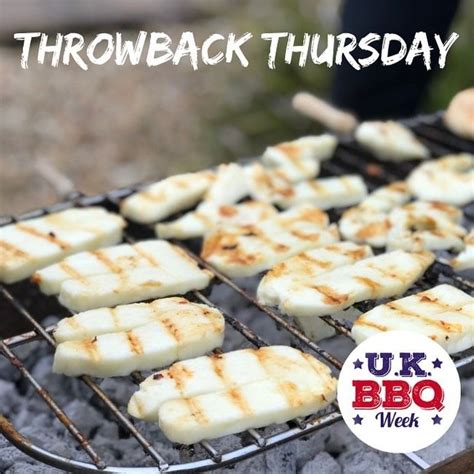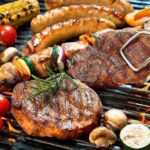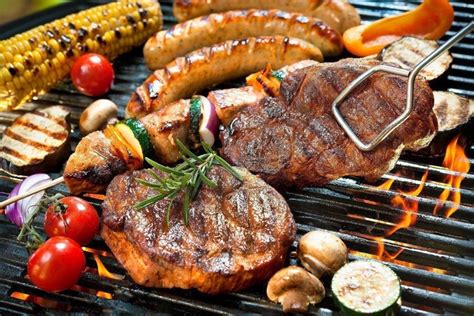
The barbecue scene is undergoing a resurgence of classic, often overlooked, dishes, prompting pitmasters and home cooks alike to revisit the traditions that defined American barbecue. This revival celebrates not just the smoky flavors but also the diverse regional techniques and historical roots of barbecue, bringing back recipes and methods that risk fading from culinary memory.
Forgotten barbecue dishes are making a comeback as chefs and enthusiasts look to the past for inspiration, reminding people of the rich heritage behind American grilling. While innovations in barbecue are ongoing, many are seeking the comfort and authenticity of time-honored recipes that once dominated cookouts and family gatherings.
Rediscovering the BBQ Classics
Barbecue is more than just grilling; it’s a cultural heritage, a communal experience, and an art form that varies widely across different regions of the United States. While contemporary barbecue often focuses on innovation with unique sauces, rubs, and techniques, there is a growing appreciation for the foundational dishes that laid the groundwork for modern barbecue.
Traditional barbecue emphasizes simplicity and patience. The focus is on quality ingredients, low-and-slow cooking methods, and techniques passed down through generations. This back-to-basics approach highlights the natural flavors of the meat, enhanced by simple seasonings and the smoky essence of wood-fired cooking.
Some of the barbecue dishes experiencing a revival include:
-
Beef Ribs: Often overshadowed by pork ribs, beef ribs are making a strong comeback. These ribs, particularly the plate ribs, offer a rich, beefy flavor and a substantial, meaty bite. Pitmasters are rediscovering the art of slow-smoking beef ribs to achieve a tender, flavorful result.
-
Smoked Turkey: Once considered a Thanksgiving staple, smoked turkey is now gaining popularity as a year-round barbecue option. Proper brining and smoking techniques are essential to keep the turkey moist and infused with smoky flavor.
-
Pork Shoulder (Boston Butt): While pulled pork remains popular, many are returning to the traditional methods of slow-smoking the entire pork shoulder (Boston butt). This allows for a greater depth of flavor and texture, resulting in a more authentic pulled pork experience.
-
Whole Hog Barbecue: A Southern tradition, whole hog barbecue involves slow-cooking an entire pig over indirect heat. This method requires significant skill and patience but delivers a diverse range of flavors and textures, from crispy skin to tender, succulent meat.
-
Smoked Sausage: From Texas hot links to Louisiana Andouille, smoked sausage is a versatile barbecue staple. Many are rediscovering the art of making their own sausage, using high-quality ingredients and traditional smoking techniques.
-
Brisket: Brisket has seen a surge in popularity in recent years and now is even more popular with innovative ways of smoking it.
Regional Variations and Techniques
American barbecue is characterized by its regional diversity, with each region boasting its own unique styles, techniques, and flavors.
-
Texas Barbecue: Known for its focus on beef, particularly brisket and beef ribs, Texas barbecue emphasizes simple seasonings and slow-smoking over oak or mesquite wood. The “holy trinity” of Texas barbecue typically includes brisket, sausage, and ribs, served with simple sides like coleslaw, potato salad, and beans.
-
Kansas City Barbecue: Characterized by its sweet and tangy sauces, Kansas City barbecue features a wide variety of smoked meats, including ribs, brisket, chicken, and pork. Burnt ends, the flavorful, caramelized edges of brisket, are a Kansas City specialty.
-
Memphis Barbecue: Known for its dry-rubbed ribs, Memphis barbecue emphasizes the flavor of the meat rather than relying heavily on sauces. Ribs can be served “wet” (with sauce) or “dry” (with a dry rub). Pulled pork is also a popular Memphis barbecue staple.
-
North Carolina Barbecue: Divided into two distinct styles, North Carolina barbecue features either whole hog barbecue (Eastern North Carolina) or pork shoulder barbecue (Western North Carolina, also known as Lexington-style). Eastern North Carolina barbecue is typically seasoned with a vinegar-based sauce, while Lexington-style barbecue features a tomato-based sauce.
-
South Carolina Barbecue: South Carolina is known for its mustard-based barbecue sauces, reflecting the state’s German heritage. Pork is the predominant meat, and whole hog barbecue is also popular.
The Importance of Wood
The type of wood used in barbecue significantly impacts the flavor of the smoked meat. Different woods impart unique flavors and aromas, adding depth and complexity to the final product.
-
Oak: A versatile wood that produces a mild, smoky flavor, oak is commonly used for smoking beef, pork, and poultry.
-
Hickory: Known for its strong, smoky flavor, hickory is often used for smoking pork, particularly ribs and shoulders.
-
Mesquite: A bold, earthy wood, mesquite is commonly used in Texas barbecue, particularly for smoking beef.
-
Pecan: A mild, nutty wood, pecan is often used for smoking poultry and pork.
-
Apple: A sweet, fruity wood, apple is often used for smoking pork and poultry.
The Role of Sauces and Rubs
Sauces and rubs play a crucial role in barbecue, adding flavor, moisture, and complexity to the smoked meat.
-
Dry Rubs: Typically a blend of spices, herbs, and salt, dry rubs are applied to the meat before smoking. They create a flavorful crust and help to tenderize the meat.
-
Sauces: Barbecue sauces vary widely in flavor and consistency, ranging from thin, vinegar-based sauces to thick, sweet sauces. Sauces can be used as a marinade, a baste, or a finishing glaze.
Techniques for Success
Mastering the art of barbecue requires attention to detail and a commitment to proper techniques.
-
Low and Slow: The key to tender, flavorful barbecue is slow-cooking the meat at a low temperature over indirect heat. This allows the connective tissues to break down, resulting in a moist, tender product.
-
Temperature Control: Maintaining a consistent temperature in the smoker is crucial for even cooking. Using a reliable thermometer and monitoring the temperature regularly is essential.
-
Moisture Management: Keeping the meat moist during the smoking process is important to prevent it from drying out. This can be achieved by using a water pan in the smoker or by spritzing the meat with a mixture of water, apple cider vinegar, or other liquids.
-
Resting the Meat: Allowing the meat to rest after smoking is crucial for retaining moisture and allowing the flavors to meld. Wrap the meat in butcher paper or foil and let it rest for at least an hour before slicing or pulling.
Modern Twists on Classic BBQ
While honoring tradition is important, many pitmasters are also incorporating modern twists and techniques into their barbecue.
-
Innovative Sauces and Rubs: Experimenting with different spice blends, herbs, and ingredients to create unique and flavorful sauces and rubs.
-
Fusion Barbecue: Blending barbecue traditions with other culinary styles, such as Asian or Latin American cuisine.
-
Sous Vide Barbecue: Using the sous vide technique to pre-cook the meat before smoking, resulting in a more tender and evenly cooked product.
-
High-Tech Smokers: Utilizing advanced smoker technology to precisely control temperature and humidity, resulting in consistent and repeatable results.
The Social and Cultural Significance of Barbecue
Barbecue is more than just a culinary tradition; it is a social and cultural phenomenon that brings people together. Barbecue gatherings are often centered around community, family, and celebration. Sharing food, stories, and laughter is an integral part of the barbecue experience.
Quotes from Pitmasters:
-
“Barbecue is about more than just cooking meat; it’s about community, family, and tradition,” says Aaron Franklin, pitmaster of Franklin Barbecue in Austin, Texas. “It’s about slowing down, taking the time to do things right, and sharing good food with good people.”
-
“The key to great barbecue is patience,” says Rodney Scott, pitmaster of Rodney Scott’s BBQ in Charleston, South Carolina. “You can’t rush the process. You have to let the meat cook slowly and develop its flavor over time.”
-
“Barbecue is a reflection of our history and our culture,” says Amy Mills, author of “Peace, Love, and Barbecue.” “It’s a way of preserving our traditions and passing them on to future generations.”
Embracing the BBQ Revival
The revival of forgotten barbecue dishes is a testament to the enduring appeal of traditional cooking methods and the rich history of American barbecue. By rediscovering these classic recipes and techniques, pitmasters and home cooks alike can reconnect with the roots of barbecue and appreciate the art of slow-smoked perfection.
The Future of BBQ
As barbecue continues to evolve, it is important to remember and honor the traditions that have shaped this culinary art form. By embracing the past while also exploring new techniques and flavors, the future of barbecue is sure to be bright.
FAQ Section
1. What are some of the forgotten BBQ dishes that are making a comeback?
Several classic BBQ dishes are experiencing a resurgence. Beef ribs, particularly plate ribs, offer a rich, beefy flavor that’s attracting attention. Smoked turkey, once mainly a Thanksgiving dish, is gaining popularity year-round. Traditional slow-smoked pork shoulder (Boston butt) methods are being revisited for a more authentic pulled pork experience. Whole hog barbecue, a Southern tradition, is making a comeback along with various types of smoked sausages. Even brisket, which has seen its popularity surge, is being re-examined and perfected by pitmasters.
2. What is the significance of regional variations in BBQ?
American barbecue is highly regionalized, with distinct styles, techniques, and flavors unique to different areas. Texas barbecue is known for its beef-centric approach, particularly brisket and beef ribs, smoked over oak or mesquite. Kansas City barbecue is characterized by its sweet and tangy sauces and a wide variety of smoked meats. Memphis barbecue is famous for its dry-rubbed ribs, while North Carolina barbecue features either whole hog (Eastern) or pork shoulder (Western) with vinegar-based or tomato-based sauces, respectively. South Carolina barbecue stands out with its mustard-based sauces, reflecting its German heritage. Understanding these regional variations is crucial to appreciating the full spectrum of American barbecue traditions.
3. How does the type of wood used affect the flavor of BBQ?
The type of wood used in barbecue significantly impacts the flavor of the smoked meat. Different woods impart unique flavors and aromas that add depth and complexity to the final product. Oak is a versatile wood that provides a mild, smoky flavor, suitable for beef, pork, and poultry. Hickory is known for its strong, smoky flavor, often used for pork, especially ribs and shoulders. Mesquite, commonly used in Texas barbecue, offers a bold, earthy flavor, perfect for beef. Pecan is a mild, nutty wood ideal for poultry and pork, while apple wood adds a sweet, fruity flavor, often used for pork and poultry. The choice of wood is a critical element in achieving the desired flavor profile.
4. What are some essential techniques for successful BBQ?
Several techniques are crucial for achieving barbecue success. Low and slow cooking, which involves cooking the meat at a low temperature over indirect heat, is essential for tenderizing the meat. Maintaining consistent temperature control within the smoker ensures even cooking. Moisture management, achieved through water pans or spritzing the meat, prevents it from drying out. Allowing the meat to rest after smoking, wrapped in butcher paper or foil, is vital for retaining moisture and allowing the flavors to meld. These techniques, combined with quality ingredients and proper seasoning, are the foundation of great barbecue.
5. How are modern BBQ pitmasters innovating while still honoring tradition?
Modern BBQ pitmasters are innovating in several ways while still respecting traditional methods. They experiment with unique and flavorful sauces and rubs using various spice blends, herbs, and ingredients. Fusion barbecue combines BBQ traditions with other culinary styles, such as Asian or Latin American cuisine. Some pitmasters use the sous vide technique to pre-cook the meat before smoking, resulting in a more tender and evenly cooked product. Additionally, advanced smoker technology is utilized to precisely control temperature and humidity, leading to consistent and repeatable results. These innovations enhance the barbecue experience while honoring the core principles of slow-smoked perfection.
Deep Dive into the Art and Science of Barbecue
The resurgence of traditional barbecue dishes signals more than just a fleeting trend; it represents a profound appreciation for the history, techniques, and cultural significance of American barbecue. To fully understand this revival, it’s essential to delve into the nuances of meat selection, preparation, cooking methods, and regional variations that define the barbecue experience.
Meat Selection and Preparation
The quality of the meat is paramount in achieving exceptional barbecue. Selecting the right cut and properly preparing it are crucial first steps.
-
Beef: Brisket and ribs (particularly plate ribs and short ribs) are the stars of the beef barbecue world. Brisket requires careful trimming to remove excess fat while leaving enough to render and keep the meat moist. Ribs should be inspected for good marbling and a thick layer of meat.
-
Pork: Pork shoulder (Boston butt) is a classic choice for pulled pork, while ribs (spare ribs and baby back ribs) are also popular. Pork shoulder benefits from a generous rub and a long, slow cooking time to break down the connective tissue.
-
Poultry: Whole chickens and turkeys are excellent candidates for smoking. Brining poultry before smoking helps to ensure moisture and flavor throughout the meat.
Rubs and Marinades: Enhancing Flavor
Rubs and marinades are essential for adding flavor and complexity to barbecue.
-
Dry Rubs: Dry rubs typically consist of a blend of spices, herbs, and salt. Common ingredients include paprika, black pepper, garlic powder, onion powder, cayenne pepper, and brown sugar. The rub is applied liberally to the meat before smoking, creating a flavorful crust.
-
Marinades: Marinades are liquid mixtures that penetrate the meat, adding flavor and moisture. Common ingredients include vinegar, soy sauce, Worcestershire sauce, garlic, herbs, and spices. Marinades are particularly useful for tougher cuts of meat, as they help to tenderize the meat fibers.
The Science of Smoke: Flavor and Preservation
Smoke is a critical component of barbecue, imparting flavor, color, and even preservative qualities to the meat.
-
Wood Smoke Chemistry: Wood smoke contains hundreds of different compounds, including phenols, carbonyls, and organic acids. These compounds interact with the meat, contributing to its characteristic smoky flavor and aroma.
-
Smoke Ring: The smoke ring, a pinkish layer just beneath the surface of the meat, is a sign of proper smoking. It is caused by the interaction of nitric oxide and carbon monoxide from the smoke with the myoglobin in the meat.
-
Controlling Smoke: Controlling the amount and type of smoke is essential for achieving the desired flavor profile. Too much smoke can result in a bitter or acrid taste, while too little smoke may not impart enough flavor.
The Art of Low and Slow Cooking
The key to tender, flavorful barbecue is low and slow cooking. This technique involves cooking the meat at a low temperature (typically between 225°F and 275°F) for an extended period of time.
-
Connective Tissue Breakdown: Low and slow cooking allows the collagen in the meat’s connective tissue to break down into gelatin, resulting in a tender, moist product.
-
Maillard Reaction: The Maillard reaction, a chemical reaction between amino acids and reducing sugars, occurs at higher temperatures, contributing to the browning and flavor development of the meat’s surface.
-
Temperature Monitoring: Accurate temperature monitoring is essential for successful low and slow cooking. Using a reliable thermometer to track both the smoker temperature and the internal temperature of the meat is crucial.
Regional Barbecue Styles: A Culinary Map
American barbecue is characterized by its regional diversity, with each region boasting its own unique styles, techniques, and flavors.
-
Texas Barbecue: Texas barbecue is known for its focus on beef, particularly brisket and beef ribs. The meat is typically seasoned with a simple rub of salt, pepper, and garlic powder and smoked over oak or mesquite wood. Texas barbecue is characterized by its simplicity and emphasis on the natural flavor of the meat.
-
Kansas City Barbecue: Kansas City barbecue is characterized by its sweet and tangy sauces, which are typically tomato-based and contain molasses, brown sugar, and vinegar. Kansas City barbecue features a wide variety of smoked meats, including ribs, brisket, chicken, and pork. Burnt ends, the flavorful, caramelized edges of brisket, are a Kansas City specialty.
-
Memphis Barbecue: Memphis barbecue is known for its dry-rubbed ribs, which are seasoned with a blend of spices and herbs before smoking. Ribs can be served “wet” (with sauce) or “dry” (with a dry rub). Pulled pork is also a popular Memphis barbecue staple.
-
North Carolina Barbecue: North Carolina barbecue is divided into two distinct styles: Eastern North Carolina and Western North Carolina (Lexington-style). Eastern North Carolina barbecue features whole hog barbecue, which is seasoned with a vinegar-based sauce. Western North Carolina barbecue features pork shoulder barbecue, which is seasoned with a tomato-based sauce.
-
South Carolina Barbecue: South Carolina barbecue is known for its mustard-based barbecue sauces, reflecting the state’s German heritage. Pork is the predominant meat, and whole hog barbecue is also popular.
Modern Innovations and Techniques
While honoring tradition is important, many pitmasters are also incorporating modern innovations and techniques into their barbecue.
-
Sous Vide Barbecue: Sous vide, a cooking technique that involves immersing food in a temperature-controlled water bath, is gaining popularity in the barbecue world. Sous vide can be used to pre-cook the meat before smoking, resulting in a more tender and evenly cooked product.
-
Pellet Smokers: Pellet smokers, which use wood pellets as fuel, offer precise temperature control and consistent smoke. They are a popular choice for both home cooks and professional pitmasters.
-
Bluetooth Thermometers: Bluetooth thermometers allow pitmasters to monitor the temperature of the smoker and the meat from their smartphones, providing real-time data and alerts.
The Community and Culture of Barbecue
Barbecue is more than just a cooking technique; it is a social and cultural phenomenon that brings people together. Barbecue gatherings are often centered around community, family, and celebration.
-
Barbecue Competitions: Barbecue competitions are popular events that showcase the skills of pitmasters from around the world. Competitions typically involve judging on taste, tenderness, appearance, and overall presentation.
-
Barbecue Restaurants: Barbecue restaurants are a staple of American cuisine, offering a wide variety of smoked meats, sides, and sauces.
-
Backyard Barbecues: Backyard barbecues are a beloved tradition, bringing friends and family together to enjoy good food and good company.
The Enduring Appeal of Barbecue
The resurgence of traditional barbecue dishes is a testament to the enduring appeal of this culinary art form. Barbecue is more than just a way to cook meat; it is a reflection of our history, our culture, and our community. By embracing the traditions of barbecue while also exploring new techniques and flavors, we can ensure that this culinary heritage continues to thrive for generations to come.
Expanded FAQ Section
1. What are the key differences between dry-rubbed and sauce-covered barbecue?
Dry-rubbed barbecue emphasizes the natural flavors of the meat, enhanced by a blend of spices and herbs applied directly to the surface before smoking. The dry rub creates a flavorful crust and helps to tenderize the meat. In contrast, sauce-covered barbecue relies on sauces to provide moisture, sweetness, tanginess, or spiciness. Sauces can be applied as a marinade, a baste during cooking, or as a finishing glaze. The choice between dry-rubbed and sauce-covered barbecue depends on regional preferences and individual taste.
2. How does brining affect the outcome of smoked poultry?
Brining involves soaking poultry in a salt-water solution (often with added sugar and spices) before smoking. This process helps to improve the moisture content and flavor of the meat. The salt in the brine denatures the proteins in the meat, allowing it to retain more water during cooking. The added sugar contributes to browning and flavor development. Brining results in a more tender, juicy, and flavorful smoked poultry product.
3. What are “burnt ends” and why are they considered a delicacy in Kansas City barbecue?
Burnt ends are the flavorful, caramelized edges of brisket that are a signature dish in Kansas City barbecue. They are typically cut from the point end of the brisket, which is richer in fat and connective tissue. During the long, slow smoking process, the edges of the brisket become deeply caramelized and develop a rich, smoky flavor. Burnt ends are highly prized for their intense flavor and tender texture, making them a sought-after delicacy in Kansas City.
4. How does the choice of fuel (wood, charcoal, gas) impact the barbecue cooking process?
The choice of fuel significantly impacts the barbecue cooking process. Wood provides a smoky flavor that is essential for traditional barbecue. Different types of wood impart unique flavors, as discussed earlier. Charcoal offers a more consistent and controllable heat source than wood, making it a popular choice for both home cooks and professional pitmasters. Gas grills provide the most convenient and controllable heat source, but they do not impart the same smoky flavor as wood or charcoal. The choice of fuel depends on individual preferences and the desired flavor profile.
5. What role does humidity play in the barbecue cooking process?
Humidity plays a crucial role in the barbecue cooking process. Maintaining adequate humidity in the smoker helps to prevent the meat from drying out during the long, slow cooking process. Humidity also helps to promote smoke penetration and flavor development. Using a water pan in the smoker is a common method for increasing humidity. Some smokers are equipped with built-in humidity control systems that allow for precise regulation of moisture levels. Proper humidity management is essential for achieving a tender, moist, and flavorful barbecue product.
6. What are some common mistakes people make when trying to barbecue?
Many mistakes can hinder barbecue success. Overcooking the meat is a frequent error, resulting in a dry, tough product. Failing to maintain consistent temperature control can lead to uneven cooking. Using too much smoke can result in a bitter or acrid taste. Neglecting to rest the meat after smoking can cause moisture loss. Overcrowding the smoker can impede airflow and result in uneven cooking. Paying attention to these common pitfalls can significantly improve barbecue outcomes.
7. How do different types of smokers affect the barbecue experience?
Various types of smokers cater to different barbecue styles and preferences. Offset smokers, known for their indirect heat and smoky flavor, are favored for Texas-style barbecue. Vertical smokers, offering efficient heat distribution, are ideal for ribs and poultry. Pellet smokers, providing consistent temperature and smoke, are versatile for both beginners and experts. Electric smokers, ensuring ease of use, are suitable for small batches and beginners. Understanding each smoker’s capabilities helps enthusiasts select the right equipment for their needs.
8. What is the “stall” in barbecue, and how can you overcome it?
The “stall” refers to the plateau in temperature that occurs during the smoking process, typically when the internal temperature of the meat reaches around 150-170°F. This is due to evaporative cooling as moisture from the meat’s surface evaporates. To overcome the stall, one can employ the “Texas crutch,” which involves wrapping the meat in butcher paper or foil to trap moisture and accelerate cooking. Alternatively, maintaining consistent temperature and humidity in the smoker can minimize the stall’s impact.
9. How has social media influenced the world of barbecue?
Social media has transformed the barbecue landscape, enabling enthusiasts to share recipes, techniques, and experiences globally. Platforms like Instagram and YouTube showcase stunning barbecue creations, inspire innovation, and foster a sense of community. Online forums and groups provide spaces for pitmasters to exchange tips, troubleshoot issues, and celebrate successes. Social media has democratized barbecue knowledge and expanded its reach to new audiences.
10. What are some up-and-coming trends in the barbecue world?
Several exciting trends are shaping the future of barbecue. Fusion barbecue, blending barbecue traditions with international cuisines, is gaining traction. Plant-based barbecue alternatives, such as smoked jackfruit and mushroom “brisket,” are catering to vegetarian and vegan audiences. High-tech barbecue equipment, including smart grills and temperature monitoring systems, is enhancing precision and convenience. Sustainability is also becoming a focus, with pitmasters emphasizing locally sourced ingredients and eco-friendly practices.









